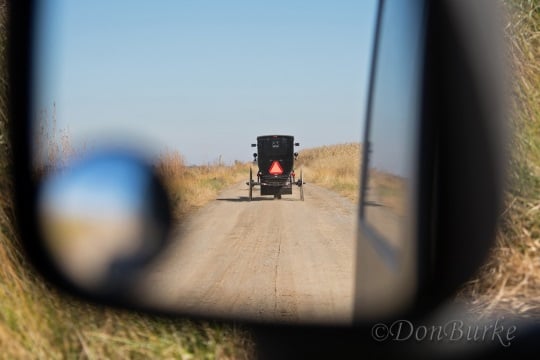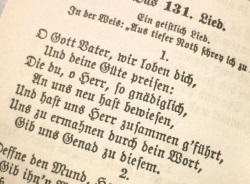3 Life Lessons From The Amish (According To A Lancaster Mennonite Pastor)
What would be the 3 biggest “life lessons” the Amish could offer the rest of us?
Lancaster County Mennonite pastor Joe Miller shares in a recent article what he feels non-Amish people can learn from the Amish example.

“Amish life lessons” or “what we can learn from the Amish” pieces are not uncommon – see these on 4 Amish health habits, 23 ways to “live Amish”, 5 lessons learned from joining the Amish, and even 13 money tips from the Amish.
The Amish live among us but quite differently from us – yet they appear to be succeeding and quite content overall – in a world that often seems wracked with strife, tension, and stress.
So it’s natural for people to look to them as some source of potential wisdom. They are a living, breathing, thriving example of an alternative.
I think there is some value in this, though it can be limited, given our non-Amish context.

Here are Joe’s 3 ideas in a nutshell, with my summary of each:
1. Moderate individualism – The individual is important but community is even moreso…”when the community is thriving, individuals in the community also thrive.” Hyper-individualism makes people feel disconnected and can breed evil consequences.
2. Value community wisdom – Elders should be respected and their words carry weight. Past wisdom is privileged. But younger members should also be listened to. Tradition is valued but change should also happen.
3. Evaluate what the modern world offers carefully – Technology gives great benefits but also takes away from life-affirming real-world interactions. And it saps our spirit via non-stop exposure to bad news and negative imagery.
What do you think? Anything you would add? I think these are good ideas, though the question somewhat remains as to how to put these into practice.
Though I suppose some ways to do that are obvious – consciously spend more time in community-upbuilding activities, interact in the real world with others (rather than the virtual one), restrict screen time and pass on chasing after the latest gadget.
In the end I think it comes down mostly to a question of will, discipline and desire to live in a more deliberate way.




Gelassenheit
I am studying Gelassenheit which is translated from the German with many English words: serenity, poise, composure, equanimity, calm, tranquility, sobriety, aplomb, calmness, placidity, imperturbability, evenness [of temperament], sangfroid, quietness [mental], sedateness, easygoingness, dispassionateness, quiet manner, self-composure, cool-headedness, laidbackness [coll.], yieldedness, self-surrender. Gelassenheit [ɡəˈlas.ən.haɪ̯t] is an important part of Amish life and signifies a submission to the will of God.
The three suggestions in this article seem in line with the concept of Gelassenheit.
Nice observation Doris, I think the concept would align with all of these. And I think I learned a couple of new words here in the translations (synonyms?). Just curious are you working on a paper or study on the Gelassenheit topic?
Gelassenheit
I wrote an article for a local broadsheet publication that caters to tourists of Amish Country in Holmes County, Ohio.
Gelassenheit
The pioneering academic study of the concept of gelassenheit and its practice among Anabaptists is Sandra Cronk’s Ph.D. dissertation. For an accessible reference, see Sandra Cronk, “Gelassenheit: The Rites of the Redemptive Process in Old Order Amish and Old Order Mennonite Communities,” Mennonite Quarterly Review 55 (1981): 5-44.
Another work on Gelassenheit
Thanks for the reference to Sandra Cronk’s dissertation Bill. While I don’t believe it is freely accessible online, here is another dissertation on the topic in which Cronk’s work is cited in multiple places, fwiw. This is from the 2012 thesis of Deborah Funk, titled Gelassenheit: The Union of Self‐Surrender and Radical Obedience, available in full at this link:
http://www.cmu.ca/library/ebooks/Gelassenheit.pdf
The Anabaptists were convinced that their faith was one of trust and their trust in God allowed
them to self‐surrender their lives so completely that they accepted martyrdom. Yet it did not
mean that they never struggled in their faith. Cronk also writes of this struggle to gain true
Gelassenheit. Yet she notes that many were willing to accept martyrdom. She writes:
Gelassenheit in the Anabaptist view has two closely related meanings. First, it means that the Christian must yield to God’s will. Each person must give up self‐will and self‐centered desires to follow God. The death of self‐will may involve both internal and external suffering. Internally there is a struggle to die to selfish desires. Externally, obedience to God’s will may bring persecution. Thousands of early Anabaptists were burned at the stake or drowned. Indeed martyrdom became a sign of a yielded life. Both internal and external yielding were ways of following Christ’s path to the cross.328
3 Life Lessons
Those are three concise points that largely do happen in the plain communities. Point #2 “Past wisdom is privileged. But younger members should also be listened to. Tradition is valued but change should also happen.” I believe we over emphasise past wisdom and under value the input of younger members. Past wisdom may not always be useful in the present. Circumstances change and the young people are more in touch with what is relevant today. There are however, also things that we older folks have experienced and had handed down to us and the younger members should not ignore them. So always a good balance of younger and older people giving input is needed.
Older vs. younger input
Thanks for the comment Osiah – from the perspective of the Amish (and I would suppose any community wishing to sustain itself) getting the balance right is the eternally tricky part.
On the one end there are the plainest churches which tend to weigh everything very heavily to the side of tradition which in turn limits their members in areas such as education (and that is arguably the point), and on the other, the churches (often the more business-oriented ones) which adopt innovations more rapidly and which trend at least from the perspective of some too quickly in the direction of the world and modern culture.
Though if it is about purely sustaining oneself as presently constituted I would think the plainer and more tradition-oriented groups would have the better prospects of that. That doesn’t necessarily mean those are the healthiest churches though.
Connection and balance...
While not about the Amish, I recently released a book regarding exploring and celebrating tradition and ritual in the Grange, a fraternal organization with strong ties to agriculture. As a result, I find positive tension can exist between old and new. Words like connection and balance become critical.
In a perhaps non-theological way, those words can lead to gelassenheit. Tradition does create stability while it also demands change and adjustment. I have long thought that the Amish have been particularly skilled at striving for that balance. It may be less about submission than it appears.
We need not be victims of tradition because we choose to give it value. As the original post suggests, we can choose to live in a deliberate, disciplined, and decisive way.
Thanks for sharing this Walter. Good points. The Amish are a living breathing case study on this tension between the two forces. And what’s makes looking at the Amish more valuable is that you have some groups calibrated more in one direction and some more in another. What’s the name of your book?
Book
I try not to engage in blatant self-promotion. 🙂 Exploring Traditions — Celebrating the Grange Way of Life. While it’s specific to Grange tradition and ritual (which tends to be based on agriculture) I see many parallels as this 150-year-old organizations tends toward polarity–out with the old, in with the new. The book (a series of essays, actually) looks at marrying the old with the new. My favorite writing mentor has asked me to write a sequel regard the value of tradition and ritual in a more general sense. It occurs to me that a comparison between the Grange and the Amish (and perhaps several other groups) could be apropos, particularly in view of the differences between the various schools of thought among the Amish. Lots of interesting stuff here… and too many books to write. 🙂
No problem Walter – I know you’re not a hit and run promoter here, you have left too many good comments here over the years. Feel free to share!
I’ll post the Amazon link to your book here for anyone who wants to check it out: https://www.amazon.com/Exploring-Traditions-Celebrating-Grange-Way-Life-ebook/dp/B07GZG9H1P
Congrats on your latest, I don’t know much about Grange tradition but will have a look now, and maybe we’ll see the Amish in a future book of yours 🙂
Thanks, Erik… There are several mentions of the Amish in Exploring Traditions and there actually is a chapter about the Amish in my first book, Small People — Big Brains. It’s called “Making Change and Making Change” and is about visiting an Amish Farm Stand in the Lancaster PA are–over the course of a decade. If you think you might be interested in posting it, I can email you a copy.
Yes please do send it along. You can reach me at ewesner(at)gmail(dot)com. It might be something for an upcoming post I have in mind. Thanks!